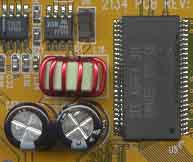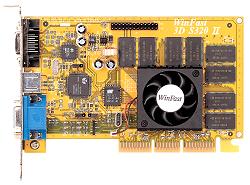Leadtek Winfast 3D S320 II 16Pro TNT2
by Anand Lal Shimpi on May 2, 1999 11:13 PM EST- Posted in
- GPUs
The Card
| The Winfast 3D S320 II is available in four unique configurations, the differentiating qualities among them being memory size and the presence of a digital LCD out port. The card AnandTech will be taking a look at in this review is the Winfast 3D S320 II-16Pro, a TNT2 based part outfitted with 16MB of SDRAM and a digital LCD out port. |
| The card is based upon NVIDIA's reference TNT2 design with a few modifications, such as the addition of a toroidial inductor at the edge of the first SDRAM chip designed to maintain the strength of the electrical current as well as limit the amount of "noise" present in the signal. Other than that particular addition, which shifted the components on the S320-II around a bit, the card is based entirely upon NVIDIA's design and should therefore be much like most other cards that are soon to come. |  |
The memory configuration on AnandTech's sample, as discussed earlier, was a 16MB setup which was composed of eight 2MB Samsung -G8 SDRAM chips. According to Leadtek, the memory clock should be set at 150MHz, although AnandTech's sample was capable of running the memory at 170MHz. After a few discussions with competing TNT2 manufacturers, it seems like some of the most popular SDRAM suppliers for TNT2 boards will be Samsung, Micron, and a not so well known manufacturer, MIRA. While AnandTech's board, equipped with Samsung -G8 chips made it up to 170MHz, the same may not be true for boards outfitted with non-Samsung modules.
Basically, when it comes to video cards, the manufacturer usually opts for the best deal they can get on memory in large quantities, so if one day Samsung SDRAM grows to be a little more expensive, don't be surprised if board manufacturers turn to other sources for solutions. The only requirement, remember, is to make sure that the memory runs fine at the speed the manufacturer spec'd the board at, and for Leadtek, 150MHz isn't a feat too difficult to achieve.
For the TNT2 itself, Leadtek clocked the processor at a safe 140MHz setting, which is high enough to provide a noticeable improvement over competing 125MHz solutions as well as older TNT and Voodoo2 cards, while low enough to insure proper operation and stability. The 0.25-micron wafers the TNT2 is cut from provide for relatively cool operation, much cooler than the older TNTs and even the new Voodoo3s. They run at a point where a simple passive heatsink would provide adequate cooling for the chip at 140MHz, however it's not surprising that Leadtek went a step further and equipped all members of the S320 II line with a heatsink/fan combo.
The fan operates quietly and performs a decent job of keeping the TNT2 cool, much better than a heatsink alone. Leadtek attached the fansink to the surface of the TNT2 using thermally conductive tape, however for the best cooling performance you may want to replace the tape with a generous amount of thermal grease, the same kind used on CPU heatsinks will do just fine. Using thermal grease (heatsink compound) isn't a requirement, but for all of you tweakers and overclockers out there it may be something you'd be interested in.
The TNT2's integrated 300MHz RAMDAC drives the analog VGA connector on the board that is accompanied by a digital LCD out port on the Pro model as well as a S-video out standard on all models. The 2D image quality of the Leadtek board wasn't bad at all at resolutions up to 1280 x 1024. Upon hitting 1600 x 1200 there was a slight albeit noticeable degradation of the 2D image (depending on how sensitive your eyes are), and each step above 1600 x 1200 also exhibited a similar drop off in quality. The quality of the 300MHz RAMDAC only accounts for half of the 2D image quality equation, the other half coming from the design of the board itself and the quality of the filters between the TNT2/memory and the VGA output. Since the S320 II is essentially a copy of NVIDIA's reference design, the 2D image quality can be considered average for a TNT2 card. Unfortunately, you probably won't ever see what "above average" for a TNT2 card will hold, since there are very few manufacturers willing to risk an increase in manufacturing cost for "awesome 2D image quality," especially not in a world where the term 3D alone sells.











0 Comments
View All Comments